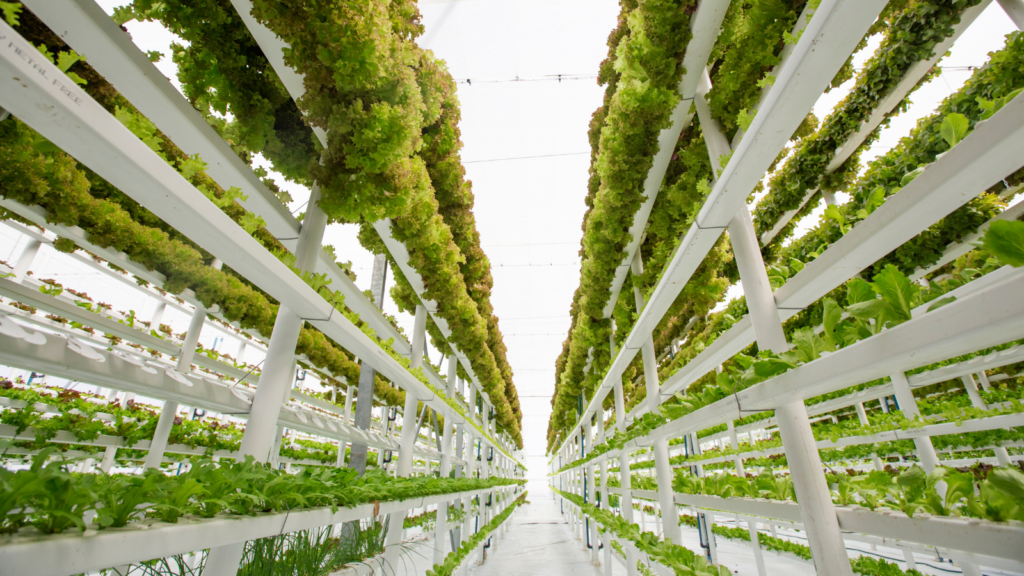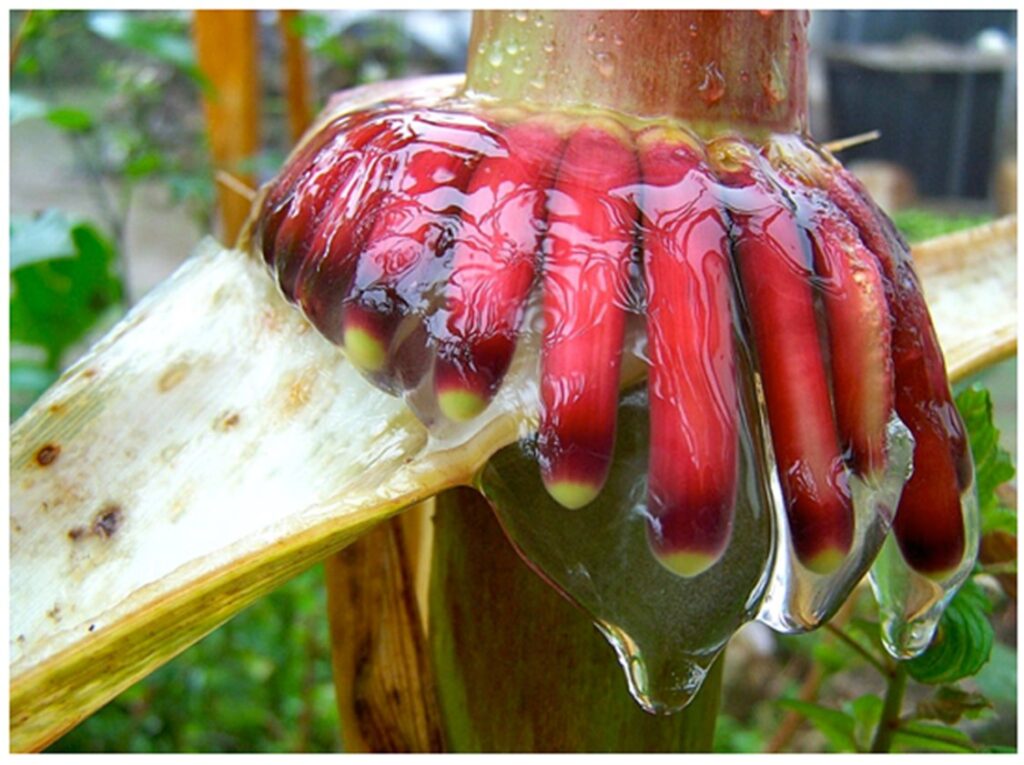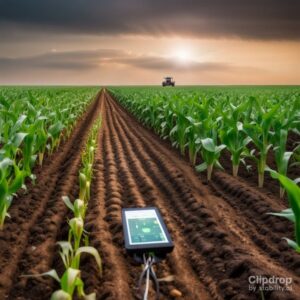
Vertical farming holds promise for the future. Image source.
By Mariana Meneses
The global challenge of food production and sustainability is a multifaceted and intricate issue.
Influenced by factors ranging from population growth and climate change to soil degradation, water scarcity, and food waste, ensuring a sustainable food supply for the future has become an imperative task as the human population continues its rapid expansion.
By 2050, the world’s population is projected to reach a staggering 9.9 billion people.
This population growth amplifies the already pressing challenges of resource scarcity, agricultural productivity, and environmental stress. Meeting the food demands of such a great number of people requires more efficient agricultural practices, especially given that intensive farming practices can cause environmental damage through deforestation, soil degradation, water pollution, and more.
Ammonia, a crucial element in modern fertilizers, presents a significant challenge, since the conventional methods employed for ammonia production are highly energy-intensive.
The Haber-Bosch process used to produce ammonia for fertilizers consumes between 3-5% of the world’s entire energy. This results in a substantial carbon footprint and contributes to the emission of greenhouse gases, thereby worsening the climate crisis. The extensive energy requirements for ammonia production not only strain our limited energy resources but also pose economic challenges due to rising energy costs.

Around the world, riverside communities rely on water quality and they are the first harmed by water contamination. Image: São Francisco River, Brazil. Credit: Renato Castro.
Moreover, the utilization of fertilizers containing ammonia contributes to the contamination of aquatic bodies, such as rivers and lakes, thereby harming not only the intricate ecosystem but also the economic subsistence of riverside communities.
Excess nitrogen from agricultural runoff, primarily derived from ammonia fertilizers, can cause eutrophication, which is the process where water bodies receive excess nutrients that stimulate excessive plant growth and lead to harmful algal blooms and oxygen depletion. These disturbances of ecological equilibrium can inflict damage to aquatic flora and fauna, unsettling the delicate balance of vulnerable ecosystems and imperiling the accessibility of untainted water resources for communities that rely upon them.
The detrimental consequences from the production and application of ammonia fertilizers underscore the pressing necessity for sustainable alternatives.
The quest for viable solutions has spurred the proactive engagement of researchers and pioneers in exploring creative or innovative approaches, such as electrochemical ammonia synthesis and biological nitrogen fixation. These groundbreaking approaches hold promise in curbing greenhouse gas emissions and fostering a greener and more sustainable framework for fertilizer manufacturing.
Numerous initiatives have emerged, each striving to promote sustainable food production.
Among these, regenerative agriculture stands out as a promising approach that emphasizes the restoration of soil health and biodiversity while simultaneously increasing food and energy production. Additionally, precision agriculture has gained traction, employing advanced technology to optimize crop yields while minimizing resource inputs like water and fertilizer. Concurrently, efforts to combat food waste through enhanced supply chain efficiency and reduced consumer waste are also gaining momentum.
The global food system is in a state of flux, with increasing demand and competition for resources. In order to meet this challenge, it is important to develop food systems that are resilient to shocks and can optimize resource use.
To forge a truly sustainable food supply chain, it is vital to invest in sustainable packaging and distribution systems.
These elements have a substantial influence on carbon emissions, food waste, and overall environmental effects of food production. For instance, the adoption of biodegradable or compostable materials for packaging can effectively diminish the ecological footprint of packaging waste. Simultaneously, optimizing transportation logistics through the employment of eco-friendly vehicles can curtail carbon emissions and alleviate the energy demands of food distribution.
Given the increasing frequency of extreme weather events and shifting climatic patterns, it is essential to invest in climate-resilient agricultural practices.
These could include the development and cultivation of drought-resistant crops that require less water and are more resilient to water scarcity, and the employment of precision irrigation systems by leveraging sensor technologies and data analysis.

“This mysterious mucus could help feed the planet and end farming’s toxic reliance on chemical fertilizers, as long as scientists can crack its code.” (BBC Earth Lab). Photo: Allen Van Deynze et al (2018).
Some argue that a big breakthrough could come from the natural world.
A Mexican type of giant maize possesses roots that produce a mysterious mucus, offering potential agricultural benefits by enabling self-fertilization and reducing the dependence on chemical fertilizers.
Nitrogen fixation, which is crucial for plant growth, allows plants to convert atmospheric nitrogen into a usable form. However, most cereal grains like corn, wheat, and rice lack this ability and rely on synthetic fertilizers. The excessive use of fertilizers not only pollutes water sources but also contributes to environmental damage.
The discovery of this plant’s self-fertilizing properties has generated more interest in sustainable agriculture.
Scientists conducted studies in Mexico and identified nitrogen-fixing bacteria within the plant’s mucus. This gel-like substance creates a low oxygen environment that facilitates the conversion of atmospheric nitrogen by its bacteria. The plant can obtain up to 80% of its required nitrogen directly from the air. To reduce reliance on synthetic fertilizers, researchers are actively working on cross-breeding to transfer its self-fertilizing capabilities.
This Slime Could Change The World | Planet Fix | BBC Earth Lab
Another recent and promising development is quantum chemistry.
Quantum chemistry plays a pivotal role in the realm of precision agriculture, and its potential applications are continually being discovered.
One study, by Dr. Julia Wright from Coventry University, highlights the possible uses of Quantum-Based Agriculture (QBA), which include improving crop and livestock health, increasing crop yields, and reducing the environmental impact of agriculture. By taking a wave-based approach to farming, QBA allows to study the effects of sound, light, and electromagnetic stimuli on plants and animals, and may explain the mechanisms by which indigenous and Biodynamic farming practices work.
Ongoing projects in Europe demonstrate practical implementation, such as ultrasound controlling algae, UV disinfection of potatoes and onions, biophoton techniques for product quality, electromagnetic treatments for horse health and mastitis reduction, and water treatment. QBA shows promise in addressing agricultural challenges and holds immense potential for advancing sustainable agriculture.
In a 2021 paper published in the journal Nature Sustainability, Lisa A. Schulte and co-authors argue that, “A dichotomy expressed as ‘food versus fuel’ has misled thinking and hindered needed action towards building agricultural systems in ways that are regenerative, biodiverse, climate resilient, equitable and economically sustainable.”

What will the future of food look like? Image: Lexica.art
It is important to note that sustainable agriculture encompasses not only environmental stewardship but also equitable access to food and fair labor practices.
Policy and governance play a vital role in promoting sustainable agricultural systems through regulations, incentives, and subsidies that encourage environmentally friendly practices and support the livelihoods of farmers. By considering the social and economic aspects alongside environmental sustainability, we can work towards a more inclusive and equitable food system that benefits both producers and consumers.
With the ongoing trend of urbanization, urban farming and vertical farming present significant opportunities to address food production challenges.

Technology and farming in a co-operative relationship. Image generated using ClipDrop.Co.
Urban farming involves cultivating food in urban areas, utilizing rooftops, vacant lots, and vertical spaces.
This approach reduces the need for long-distance transportation, thereby lowering carbon emissions and energy consumption associated with food distribution. Moreover, vertical farming maximizes land efficiency and water usage while minimizing the need for pesticides and fertilizers. These innovative practices enable local food production, enhance food security in urban areas, and contribute to the resilience and sustainability of the overall food system.
We can see how revolutionizing food production to meet the challenges of a growing world population requires a multifaceted and sustainable approach.
Through collective efforts and the adoption of innovative technologies and policies, we can ensure a sustainable food supply for generations to come.



